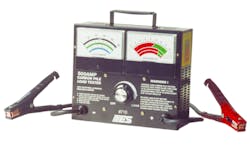Tech Tip: The advantages of load testers
Diagnosing any cranking or drivability complaint should begin with a test of the vehicles battery before proceeding. Therefore, every repair shop needs to own a battery tester and there are two ways to go: digital and load testers. Take some time to decide which type of tester is best for your shop.
Load testers typically feature two analog meters, one for the test voltage and another for the load test amperage. The usual test sequence involves applying a load to the battery for 15 seconds and noticing the battery voltage at the end of the 15 seconds. The amount of load (amperage) applied to the battery should equal half the CCA rating of the battery.
On the inside, load testers use a fixed or adjustable resistor of some kind, like carbon plates.
The concept of the load tester is this: you are applying a load to the battery which is very similar to the vehicle's engine actual cranking load. If the battery voltage falls below 10 volts, then the battery's ability to crank the engine is in serious question. It is an effective test and has stood the test of time.
There are a variety of load tester configurations on the market, some even feature digital readouts and incorporate amp probes for additional diagnostics. As compared to the newer digital types, the hook-ups and overall process takes more time. Additionally, the load testers are heavy and less portable, but they do provide very consistent test results.
To read about the advantages of digital battery testers, click here.
Information provided by: Electronic Specialties, Inc.
